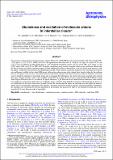Por favor, use este identificador para citar o enlazar a este item:
http://hdl.handle.net/10261/347736COMPARTIR / EXPORTAR:
 SHARE SHARE
 CORE
BASE CORE
BASE
|
|
| Visualizar otros formatos: MARC | Dublin Core | RDF | ORE | MODS | METS | DIDL | DATACITE | |

| Título: | The abundance and excitation of molecular anions in interstellar clouds |
Autor: | Agúndez, Marcelino CSIC ORCID; Marcelino, Nuria CSIC ORCID; Tercero, Belén CSIC ORCID; Jimenez-Serra, I.; Cernicharo, José CSIC ORCID | Palabras clave: | Astrochemistry ISM: Molecules Line: Identification Molecular processes Radiative transfer Radio lines: ISM Astro-ph.GA |
Fecha de publicación: | 10-jul-2023 | Editor: | EDP Sciences | Citación: | Astronomy & Astrophysics 677: A106 (2023) | Resumen: | We report new observations of molecular anions with the Yebes 40m and IRAM 30m telescopes toward the cold dense clouds TMC-1 CP, Lupus-1A, L1527, L483, L1495B, and L1544. We detected for the first time C3N- and C5N- in Lupus-1A and C4H- and C6H- in L483. In addition, we report new lines of C6H- toward the six targeted sources, of C4H- toward TMC-1 CP, Lupus-1A, and L1527, and of C8H- and C3N- in TMC-1 CP. Excitation calculations indicate that the lines of anions accessible to radiotelescopes run from subthermally excited to thermalized as the size of the anion increases, with the degree of departure from thermalization depending on the H2 volume density and the line frequency. We noticed that the collision rate coefficients available for the radical C6H cannot explain various observational facts, which advises for a revisitation of the collision data for this species. The observations presented here, together with observational data from the literature, are used to model the excitation of interstellar anions and to constrain their abundances. In general, the anion-to-neutral ratios derived here agree within 50 % (a factor of two at most) with literature values, when available, except for the C4H-/C4H ratio, which shows higher differences due to a revision of the dipole moment of C4H. From the set of anion-to-neutral abundance ratios derived two conclusions can be drawn. First, the C6H-/C6H ratio shows a tentative trend in which it increases with increasing H2 density, as expected from theoretical grounds. And second, it is incontestable that the higher the molecular size the higher the anion-to-neutral ratio, which supports a formation mechanism based on radiative electron attachment. Nonetheless, calculated rate coefficients for electron attachment to the medium size species C4H and C3N are probably too high and too low, respectively, by more than one order of magnitude. | Descripción: | 21 pags., 10 figs., 6 tabs. | URI: | http://hdl.handle.net/10261/347736 | DOI: | 10.1051/0004-6361/202347077 | ISSN: | 0004-6361 |
| Aparece en las colecciones: | (CFMAC-IFF) Artículos (CAB) Artículos |
Ficheros en este ítem:
| Fichero | Descripción | Tamaño | Formato | |
|---|---|---|---|---|
| aa_Agundez_et_al_2023.pdf | Artículo principal | 1,01 MB | Adobe PDF |  Visualizar/Abrir |
CORE Recommender
SCOPUSTM
Citations
7
checked on 19-abr-2024
WEB OF SCIENCETM
Citations
3
checked on 28-feb-2024
Page view(s)
22
checked on 27-abr-2024
Download(s)
9
checked on 27-abr-2024
Google ScholarTM
Check
Altmetric
Altmetric
Este item está licenciado bajo una Licencia Creative Commons

